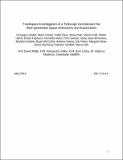Tradespace Investigation of a Telescope Architecture for Next-generation Space Astronomy and Exploration
Author(s)
Cataldo, Giuseppe; Chodas, Mark; Dave, Pratik; Dixit, Atray; Hall, Sherrie; Harris, Robert; Hayhurst, Dustin; Hicks, Fernando; Jewison, Christopher; Josan-Drinceanu, Ioana; Karlow, Brandon; McCarthy, Bryan; Owens, Andrew; Peters, Eric; Shaw, Margaret; Sternberg, David; Voelbel, Kathleen; Wu, Marcus; ... Show more Show less
DownloadTITANS AE SSL Report.pdf (11.98Mb)
Terms of use
Metadata
Show full item recordAbstract
Humanity’s endeavor to further its scientific understanding of the celestial heavens has led to the creation and evolution of increasingly powerful and complex space telescopes. Space telescopes provide a view of the solar system, galaxy, and universe unobstructed by Earth’s atmosphere and have profoundly changed the way people view space. In an effort to further advance space telescope capability and achieve the accompanying scientific understanding, the Massachusetts Institute of Technology (MIT), specifically, course 16.89 Space Systems Engineering, explored the tradespace of architectural enumerations encompassed within the design of an ultraviolet-optical-infrared (UVOIR) space telescope located at Sun-Earth Lagrangian Point Two (SE-L2). SE-L2 presents several advantages as an operating location for a UVOIR telescope such as a thermally stable environment and an orbit that allows the telescope to maintain a constant orientation with respect to all of the primary sources of heat and light. The main disadvantages associated with SE-L2 are caused by its relatively large distance from Earth, which marginalizes the effectiveness of real-time telerobotics because of latency and increases the cost of communications, launch, and servicing. Course 16.89 believes that, for this UVOIR application, the strengths of this operating location outweigh its weaknesses and therefore decided to explore the family of opportunities associated with SE-L2.
This course used appropriate performance and system metrics to quantify the effectiveness of the aforementioned architectures and create a Pareto front of viable architectures. Evaluating the designs along the Pareto front allowed the course to characterize and group architectures and present these group-types to stakeholders for the selection of an optimal space telescope according to stakeholder requirements and resources. This course also developed sensitivity analysis, which allowed for a greater understanding of how architectural decisions affect the performance of the satellite. Segmentation, modularity, assembly, autonomy, and servicing were key aspects of this multidimensional analysis given the 16.8-meter class size and location of the telescope. Within the respective operating environment and for a spacecraft of similar characteristics, this model will allow stakeholders to predict the long-term operational effectiveness of different space telescope architectures and capture the synergistic effects of combining various architectural decisions into a spacecraft design.
The following sections step through the aforesaid analysis and design efforts conducted in 16.89 beginning with Section III, which explicitly performs the stakeholder analysis and articulates the requirements of the mission. Section IV gives an overview of past designs and expands upon the architecture enumerations pertinent to this project, while Section V presents the methods and metrics by which those architectures will be evaluated and the system metrics which will be balanced and optimized in the creation of this space telescope. Section VI will present the model validation of this project and Section VII will discuss the results and analyses of the project. Finally, Section VIII will explore the future work opportunities of this project, while Section IX will present the conclusions and recommendations drawn from this project.
Date issued
2014-12-19Series/Report no.
SSL Report;13-14
Keywords
Large Space Telescopes, Telescope Design, Tradespace Exploration, Telescope System Design, Servicing, Assembly, Modularity
Collections
The following license files are associated with this item: